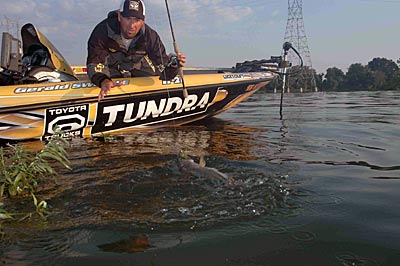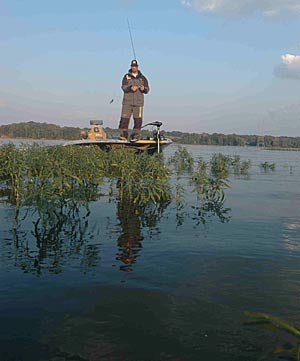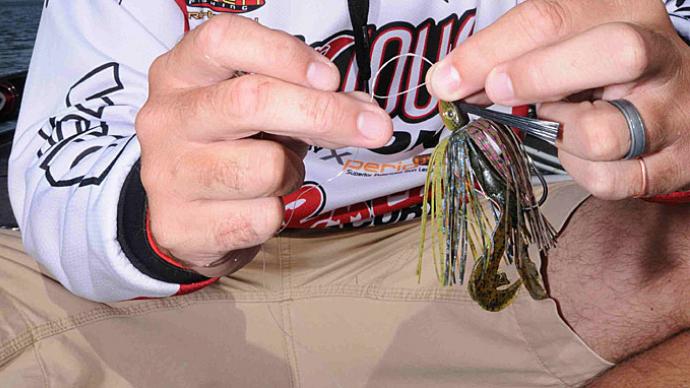
When bass are in grass, Gerald Swindle relies on a jig specially designed for luring fish from the vegetation.
“A swim jig usually has a little bit heavier hook on it for strength because 99 percent of the time you are swimming it with braid,” Swindle says. “It has a little bit heavier weed guard because you are mostly swimming it in grass and almost all swim jigs have some sort of pointed head (for cutting through the grass).”
The Alabama pro has noticed times when he has seen bass in the grass and the fish ignored everything he threw at them but then ate a swim jig. “It is that one bait that mimics the crawfish burning or swimming through the grass real fast or a bream breaking through the grass,” Swindle says. “If it is fished correctly at the right speed a bass just doesn’t have a great opportunity to figure out if it is artificial or real.”
The Bassmaster Elites Series pro believes the swim jig triggers reaction strikes because bass rarely get a good look at the lure as it moves quickly through the weeds. “There are times when you swim a jig in open water or along retaining walls when you fish it like a spinnerbait with shad colors, but when you get in that grass it is the speed of the bait that is making that fish react,” he says.
One of Swindle’s favorite times to throw the swim jig is in later winter or early spring when lakes receive some rain and the water temperature climbs to 55 to 58 degrees. “You don’t catch the numbers then but you can absolutely catch a giant,” he says.
Another prime time to fish a swim jig is during the shad spawn. Postspawn bass are guarding fry and are attacking spawning shad then so Swindle recommends using a swim jig in a light glimmer blue or pale white hue with a white plastic chunk to mimic shad.
Swindle usually throws homemade swim jigs but also favors a Buckeye Lures J-Will Swim Jig or a Dirty Jigs Swim Jig. The two-time Bassmaster Angler of the Year winner says he throws a 5/16-ounce swim jig “99 percent of the time.” During the late winter/early spring period he opts for a black/blue jig with a black/blue plastic chunk or Zoom Z Craw trailer. “If the water is dirty I will go with a sapphire blue chunk,” Swindle says. He selects a jig with a mixture of green, orange and blue with a green pumpkin trailer when bream are active in the grass.
The touring pro avoids using bright white for his swim jig because he believes bass overreact to the lure and try to blow it out of the water without eating the jig. “It seems like when I go with those real outlandish wild bright colors I miss more fish than I catch,” he says.

The only modification he makes to his swim jig is to trim the skirt to prevent inhibiting the action of his trailer. “On a swim jig you always need to make sure whatever trailer you are fishing that the jig skirt has been trimmed enough so it doesn’t interfere with the action of the trailer’s legs,” he says.
Swindle looks for specific targets when swimming a jig in the grass. “Ninety percent of the time I want to find a clump about the size of a bucket in an area that has sparse thin grass,” he says. “For whatever reason that is what you want to swim the jig over. If the grass is super thick and there is one little bitty isolated thin patch sticking out in front of it, the fish will be on that patch as well.”
The 17–time Bassmaster Classic qualifier makes a lengthy cast past his target and keeps his rod at about a 10:30 position while simultaneously reeling and shaking the jig to keep it about 2 to 6 inches under the surface. He tries to swim the jig through the clump of grass or alongside the clump if the grass is too thick. When his jig passes the target he kills his retrieve and lets the jig fall about 1 foot before reeling it again. He notes strikes usually occur when the jig enters or passes the clump of grass.
His tackle for swimming a jig in weeds consists of a 7-foot, 4-inch Quantum medium-heavy casting rod and a Quantum PT Smoke S3 baitcast reel filled with 40-pound Sunline Asegai braided line.
Swindle believes the key to fishing a swim jig is covering a lot of water. “If there are 50 bass in a grass mat along a 700-yard stretch you are only going to get two or three to bite,” he says. “So you need to put the trolling motor on about 4 or 5 and find a comfortable method in which you can be very thorough at a pace where you are covering water.”
The tournament veteran notices the biggest mistake novices make when fishing swim jigs is jerking the rod too fast after seeing a blowup. “Don’t jerk until you feel the fish pull the rod down,” he says.
BassResource may receive a portion of revenues if you make a purchase using a link above.




